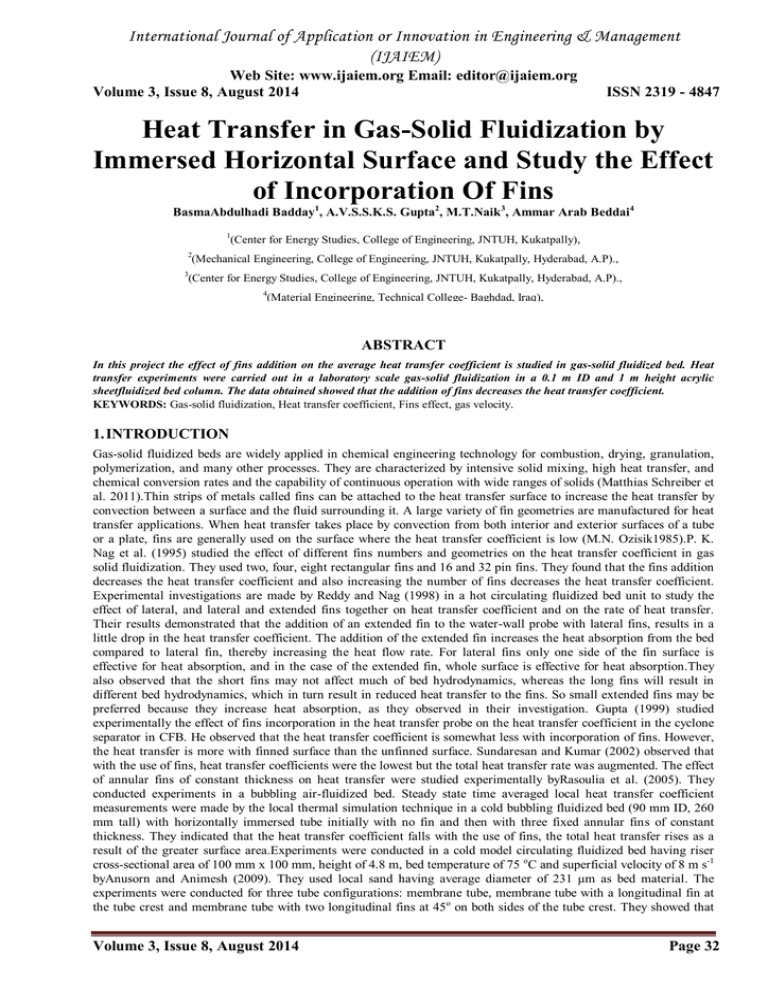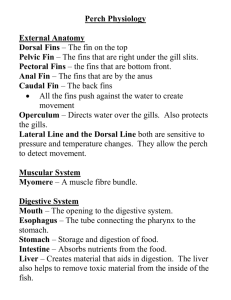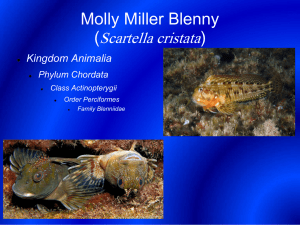Heat Transfer in Gas-Solid Fluidization by (IJAIEM)
advertisement

International Journal of Application or Innovation in Engineering & Management (IJAIEM) Web Site: www.ijaiem.org Email: editor@ijaiem.org Volume 3, Issue 8, August 2014 ISSN 2319 - 4847 Heat Transfer in Gas-Solid Fluidization by Immersed Horizontal Surface and Study the Effect of Incorporation Of Fins BasmaAbdulhadi Badday1, A.V.S.S.K.S. Gupta2, M.T.Naik3, Ammar Arab Beddai4 1 (Center for Energy Studies, College of Engineering, JNTUH, Kukatpally), 2 (Mechanical Engineering, College of Engineering, JNTUH, Kukatpally, Hyderabad, A.P)., 3 (Center for Energy Studies, College of Engineering, JNTUH, Kukatpally, Hyderabad, A.P)., 4 (Material Engineering, Technical College- Baghdad, Iraq), ABSTRACT In this project the effect of fins addition on the average heat transfer coefficient is studied in gas-solid fluidized bed. Heat transfer experiments were carried out in a laboratory scale gas-solid fluidization in a 0.1 m ID and 1 m height acrylic sheetfluidized bed column. The data obtained showed that the addition of fins decreases the heat transfer coefficient. KEYWORDS: Gas-solid fluidization, Heat transfer coefficient, Fins effect, gas velocity. 1. INTRODUCTION Gas-solid fluidized beds are widely applied in chemical engineering technology for combustion, drying, granulation, polymerization, and many other processes. They are characterized by intensive solid mixing, high heat transfer, and chemical conversion rates and the capability of continuous operation with wide ranges of solids (Matthias Schreiber et al. 2011).Thin strips of metals called fins can be attached to the heat transfer surface to increase the heat transfer by convection between a surface and the fluid surrounding it. A large variety of fin geometries are manufactured for heat transfer applications. When heat transfer takes place by convection from both interior and exterior surfaces of a tube or a plate, fins are generally used on the surface where the heat transfer coefficient is low (M.N. Ozisik1985).P. K. Nag et al. (1995) studied the effect of different fins numbers and geometries on the heat transfer coefficient in gas solid fluidization. They used two, four, eight rectangular fins and 16 and 32 pin fins. They found that the fins addition decreases the heat transfer coefficient and also increasing the number of fins decreases the heat transfer coefficient. Experimental investigations are made by Reddy and Nag (1998) in a hot circulating fluidized bed unit to study the effect of lateral, and lateral and extended fins together on heat transfer coefficient and on the rate of heat transfer. Their results demonstrated that the addition of an extended fin to the water-wall probe with lateral fins, results in a little drop in the heat transfer coefficient. The addition of the extended fin increases the heat absorption from the bed compared to lateral fin, thereby increasing the heat flow rate. For lateral fins only one side of the fin surface is effective for heat absorption, and in the case of the extended fin, whole surface is effective for heat absorption.They also observed that the short fins may not affect much of bed hydrodynamics, whereas the long fins will result in different bed hydrodynamics, which in turn result in reduced heat transfer to the fins. So small extended fins may be preferred because they increase heat absorption, as they observed in their investigation. Gupta (1999) studied experimentally the effect of fins incorporation in the heat transfer probe on the heat transfer coefficient in the cyclone separator in CFB. He observed that the heat transfer coefficient is somewhat less with incorporation of fins. However, the heat transfer is more with finned surface than the unfinned surface. Sundaresan and Kumar (2002) observed that with the use of fins, heat transfer coefficients were the lowest but the total heat transfer rate was augmented. The effect of annular fins of constant thickness on heat transfer were studied experimentally byRasoulia et al. (2005). They conducted experiments in a bubbling air-fluidized bed. Steady state time averaged local heat transfer coefficient measurements were made by the local thermal simulation technique in a cold bubbling fluidized bed (90 mm ID, 260 mm tall) with horizontally immersed tube initially with no fin and then with three fixed annular fins of constant thickness. They indicated that the heat transfer coefficient falls with the use of fins, the total heat transfer rises as a result of the greater surface area.Experiments were conducted in a cold model circulating fluidized bed having riser cross-sectional area of 100 mm x 100 mm, height of 4.8 m, bed temperature of 75 oC and superficial velocity of 8 m s-1 byAnusorn and Animesh (2009). They used local sand having average diameter of 231 μm as bed material. The experiments were conducted for three tube configurations: membrane tube, membrane tube with a longitudinal fin at the tube crest and membrane tube with two longitudinal fins at 45o on both sides of the tube crest. They showed that Volume 3, Issue 8, August 2014 Page 32 International Journal of Application or Innovation in Engineering & Management (IJAIEM) Web Site: www.ijaiem.org Email: editor@ijaiem.org Volume 3, Issue 8, August 2014 ISSN 2319 - 4847 the membrane tubes with one and two longitudinal fins have higher heat transfer than membrane tubes and the heat is mainly transferred in the combination portion of tube and membrane fins. 2. EXPERIMENTAL SET UP Laboratory scale fluidized bed setup can be shown in figure 1, the experiments were conducted in a 0.1 m ID and 1 m height acrylic fluidization column. Air was supplied by a compressor. The air flow was measured by a rotameter. The air was passing through the plenum chamber filled by glass beads to maintain uniform distribution of air through bed, with a height of 0.1m and upper diameter of 0.1m and bottom diameter of 0.015m. The air was distributed by a perforated plate of mild steel with a diameter of 0.1m and a thickness of 0.003 m will consists of 256 holes of 2.7 mm diameter drilled on a 7.5 mm square pitch. An ultrafine mesh was fixed on the distributor plate to prevent bed particles leakage. There were 10 pressure ports in the fluidized column for pressure drop measurements. The heat transfer section consisted from horizontal heat transfer probe. Fig.2 a horizontal probe located on 0.29 m above the distributer was made of copper rod (15 mm ODx50 mm long) and insulated at the ends by Teflon. A hole was drilled at the center of the rod to accommodate a cartridge heater 200 W (6.5 mm OD x50 mm long). Four radial rectangular fins were made of copper with dimensions of (0.6cm height x 0.4cm thickness) was welded to the probe. Three T-type thermocouple were fixed on the surface of the probe to measure the temperature of the heat transfer surface and two thermocouples were installed above and below the probe to measure the bed temperature. These thermocouples were calibrated before use. The power input to the probe was controlled by a variable direct current power supply. The supplied heat flux was determined by measuring voltage (V) and current (I). An ultrafine mesh was fixed on the top end of the column to avoid escaping the particles from the top. Local sand of three different sizes 301µm, 454µm and 560 µm were used as the bed material. Three bed inventories of sand 1.5 kg, 2.0 kg, and 2.5 kg, four superficial air velocities of 1.0 m/s, 1.25 m/s, 1.5 m/s, 1.75 m/s were used. Three heat fluxes of 1698.9, 2928.4, 4675.7 W m -2 were employed. The local heat transfer coefficient along the probe were estimated from the equation: (1) Where, (2) A is the cross-sectional area of heat transfer surface,Tsi is the heat transfer surface temperature in the ith location, Tbiis the bed temperature in the ith location, V is the voltage and I is the current. The cross-sectional area of the horizontal heat transfer probe is: (3) Where Af is fin area. Figure 1 experimental set up 1-compressoe, 2-Valve, 3-air rotameter, 4-plenum chamber, 5- Horizontal heat transfer probe with fins, 6thermocouples, 7- digital screen, 8- DC power supply, 9-five U manometers. 3. RESULT AND DISCUSSION The effect of addition of the fins in heat transfer probe can be seen in figure (2). As observed in the figure, the heat transfer coefficient is less when using rectangular fins. This may be due to increase the heat transfer surface area, this Volume 3, Issue 8, August 2014 Page 33 International Journal of Application or Innovation in Engineering & Management (IJAIEM) Web Site: www.ijaiem.org Email: editor@ijaiem.org Volume 3, Issue 8, August 2014 ISSN 2319 - 4847 h W/m 2 . oC increased area disturbs the gas-particles flow. Similar effect is observed in the literature (Gupta 1999 and Rasouli, 2009). 210 190 170 150 130 110 90 no fin rectangular fins 0.95 1.15 1.35 1.55 1.75 1.95 Ug m/s Figure 2 Effect of incorporation of fins on heat transfer coefficient for different gas velocities, for I=1.5 kg, for dp=301μm, and for q=1698.9 W/m2. 4. CONCLUSION It can be concluded from this research that the addition of fins decreases the heat transfer coefficient due to large heat transfer surface which causes flow disturbance. REFERENCES [1] M. Schreiber, T. W. Asegehegn, and H. J. Krautz, Numerical and Experimental Investigation of Bubbling GasSolid Fluidized Beds with Dense Immersed Tube Bundles, Ind. Eng. Chem. Res. 2011, 50, 7653–7666. [2] M.N. Ozisik, Heat Transfer- Abasic Approach, McGraw-Hill, New York (1985). [3] P. K. Nag, M. Nawsher Ali and P. Basu, A mathematical model for the prediction of heat transfer from finned surfaces in a circulating fluidized bed, Int. J. Heat Mass Transfer, Vol. 38, No. 9, pp. 1675-1681, 1995. [4] B. V. Reddy And P. K. Nag, Effect Of Lateral And Extended Fins On Heat Transfer In A Circulating Fluidized Bed, Int. J. Heat Mass Transfer. Vol. 41. No. 1, Pp. 139 146. 1998. [5] A.V.S.S.K. S. Gupta, Some Heat Transfer and Thermodynamics Studies of Combined Cycle Power Generation, Ph.D thesis, 1999. [6] R. Sundaresan, Ajit Kumar Kolar, Core heat transfer studies in a circulating fluidized bed, Powder Technology 124 (2002) 138– 151. [7] S. Rasoulia, M.R. Golrizb, A.A. Hamidi, Effect Of Annular Fins On Heat Transfer Of A Horizontal Immersed Tube In Bubbling Fluidized Beds, Powder Technology 154 (2005) 9 –13. [8] AnusornChinsuwan, AnimeshDutta, An Experimental Investigation Of The Effect Of Longitudinal Fin Orientation On Heat Transfer In Membrane Water Wall Tubes In A Circulating Fluidized Bed, International Journal Of Heat And Mass Transfer 52 (2009) 1552–1560. Volume 3, Issue 8, August 2014 Page 34





